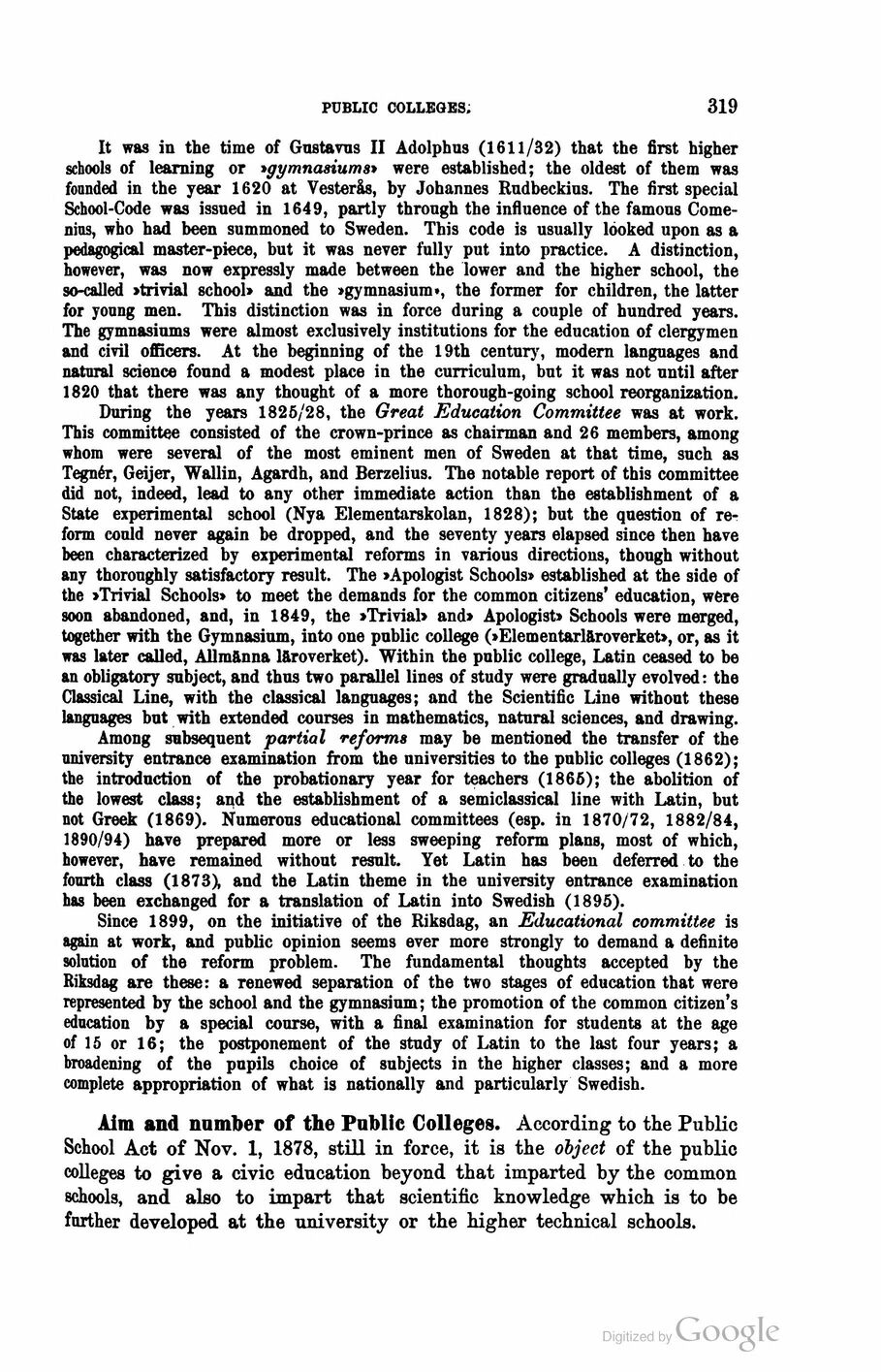
Full resolution (JPEG) - On this page / på denna sida - First part - IV. Education and Mental Culture - 2. Public Colleges and corresponding Institutions - Public Colleges

<< prev. page << föreg. sida << >> nästa sida >> next page >>
Below is the raw OCR text
from the above scanned image.
Do you see an error? Proofread the page now!
Här nedan syns maskintolkade texten från faksimilbilden ovan.
Ser du något fel? Korrekturläs sidan nu!
This page has never been proofread. / Denna sida har aldrig korrekturlästs.
PUBLIC COLLEGES.
319
It was in the time of Gustavus II Adolphus (1611/32) that the first higher
schools of learning or »gymnasiums* were established; the oldest of them was
founded in the year 1620 at Vesterås, by Johannes Rudbeckius. The first special
School-Code was issued in 1649, partly through the influence of the famous
Come-nius, who had been summoned to Sweden. This code is usually looked upon as a
pedagogical master-piece, but it was never fully put into practice. A distinction,
however, was now expressly made between the lower and the higher school, the
so-called »trivial school» and the »gymnasium», the former for children, the latter
for young men. This distinction was in force during a couple of hundred years.
The gymnasiums were almost exclusively institutions for the education of clergymen
and civil officers. At the beginning of the 19th century, modern languages and
natural science found a modest place in the curriculum, but it was not until after
1820 that there was any thought of a more thorough-going school reorganization.
During the years 1825/28, the Great Education Committee was at work.
This committee consisted of the crown-prince as chairman and 26 members, among
whom were several of the most eminent men of Sweden at that time, such as
Tegnér, Geijer, Wallin, Agardh, and Berzelius. The notable report of this committee
did not, indeeid, lead to any other immediate action than the establishment of a
State experimental school (Nya Elementarskolan, 1828); hut the question of
reform could never again be dropped, and the seventy years elapsed since then have
been characterized by experimental reforms in various directions, though without
any thoroughly satisfactory result. The »Apologist Schools» established at the side of
the »Trivial Schools» to meet the demands for the common citizens’ education, were
soon abandoned, and, in 1849, the »Trivial» and» Apologist» Schools were merged,
together with the Gymnasium, into one public college (»Elementarläroverket», or, as it
was later called, Allm&nna läroverket). Within the public college, Latin ceased to be
an obligatory subject, and thus two parallel lines of study were gradually evolved: the
Classical Line, with the classical languages; and the Scientific Line without these
languages but with extended courses in mathematics, natural sciences, and drawing.
Among subsequent partial reforms may be mentioned the transfer of the
university entrance examination from the universities to the public colleges (1862);
the introduction of the probationary year for teachers (1865); the abolition of
the lowest class; and the establishment of a semiclassical line with Latin, but
not Greek (1869). Numerous educational committees (esp. in 1870/72, 1882/84,
1890/94) have prepared more or less sweeping reform plans, most of which,
however, have remained without result. Yet Latin has been deferred to the
fourth class (1873), and the Latin theme in the university entrance examination
has been exchanged for a translation of Latin into Swedish (1895).
Since 1899, on the initiative of the Riksdag, an Educational committee is
again at work, and public opinion seems ever more strongly to demand a definite
solution of the reform problem. The fundamental thoughts accepted by the
Riksdag are these: a renewed separation of the two stages of education that were
represented by the school and the gymnasium; the promotion of the common citizen’s
education by a special course, with a final examination for students at the age
of 15 or 16; the postponement of the study of Latin to the last four years; a
broadening of the pupils choice of subjects in the higher classes; and a more
complete appropriation of what is nationally and particularly Swedish.
Aim and number of the Public Colleges. According to the Public
School Act of Nov. 1, 1878, still in force, it is the object of the public
colleges to give a civic education beyond that imparted by the common
schools, and also to impart that scientific knowledge which is to be
further developed at the university or the higher technical schools.
<< prev. page << föreg. sida << >> nästa sida >> next page >>